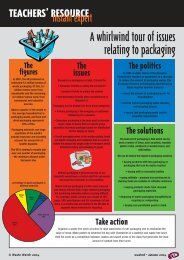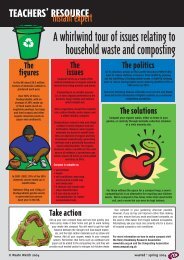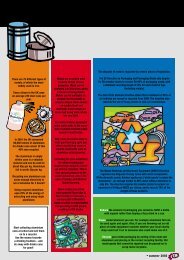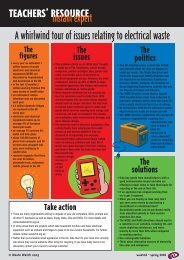A waste-free picnic - pdf 200k - Recyclezone
A waste-free picnic - pdf 200k - Recyclezone
A waste-free picnic - pdf 200k - Recyclezone
You also want an ePaper? Increase the reach of your titles
YUMPU automatically turns print PDFs into web optimized ePapers that Google loves.
PRIMARY SCHOOL TEACHER’S NOTESA <strong>waste</strong>-<strong>free</strong> <strong>picnic</strong>Learning objectivesAt the end of the activity, children will:Understand what ‘reduce’, ‘reuse’, ‘recycle’ and ‘compost’ mean;Understand why reducing food <strong>waste</strong> and packaging <strong>waste</strong> is important;Have worked successfully in groups to achieve a goal;Have communicated the need to cut food and packaging <strong>waste</strong> to their parents.Curriculum LinksMaths, Design & Technology, Citizenship and Education for Sustainable Development.Sustainable Schools Doorway1 Food and Drink, 4 Purchasing and Waste.IntroductionA <strong>waste</strong>-<strong>free</strong> <strong>picnic</strong> isa fun way to learnabout food <strong>waste</strong>,packaging <strong>waste</strong>,and the importanceof cutting down onwhat we throw away.Lesson 1 - Planning the <strong>picnic</strong>Explain that children will work ingroups to plan a special <strong>picnic</strong> thatproduces as little <strong>waste</strong> as possible.Divide the children into groups offour or five to brainstorm the types offood they could bring to a ‘<strong>waste</strong>-<strong>free</strong>’<strong>picnic</strong>, which would minimise both leftover food and packaging <strong>waste</strong>.Bring the class together to shareideas. Encourage children to notedown good ideas from other groups.Divide the class into groups for asecond time to decide what foodand drink each group member will bringfor the <strong>picnic</strong>.Ask the children to bag up and bringin any <strong>waste</strong> from the preparation oftheir <strong>picnic</strong> food at home (eg. breadbags, vegetable peelings). It might be agood idea to send a letter to parentsbeforehand to explain the activity andwhat is required.Lesson 2 - The <strong>picnic</strong>Recap the aims of the <strong>waste</strong>-<strong>free</strong><strong>picnic</strong> to make sure the childrenunderstand them.Each group should set up their<strong>picnic</strong>. Provide each group with fourplastic bags (ideally, reused ones)labelled as per the table at the bottom ofthe pupil sheet. Ask them to sort the<strong>waste</strong> they produced at home into thesebags, and check that they understandwhere different materials should go.Give the children time to eat their<strong>picnic</strong>s and then ask them to put allthe <strong>waste</strong> in the appropriate bags.Groups should then weigh each bagusing spring balances and recordthe weights in the table on the worksheet. Each type of <strong>waste</strong> has beengiven ‘Waste Points’ depending on howmuch it harms the environment - thelower the number of points, the lessharmful it is.Each group should multiply theweight of each type of <strong>waste</strong> by its'Waste Points'. Then add them up to geta final score - lowest wins!Extension ideas• Ask children to write a letter to their parents explaining the aim of the task, whatthey need to bring and why. Even better, invite parents to join in with the <strong>picnic</strong>!• This idea can be adapted for use at any time of year, indoors and outdoors, forexample for a Christmas party.
PRIMARY SCHOOL PUPIL WORKSHEETA <strong>waste</strong>-<strong>free</strong> <strong>picnic</strong>Lesson summaryWorking in groupsyou get to plan andenjoy a <strong>picnic</strong>, whichproduces as little<strong>waste</strong> as possible.Each group will thenweigh their leftoversand score <strong>waste</strong>points. The groupwith the lowest scorewins!Tips for the <strong>waste</strong>-<strong>free</strong> <strong>picnic</strong>12345678910Choose food that you and others willlike.Don’t bring more food than yourgroup can comfortably eat.Choose food that has as littlepackaging as possible.Think about whether you will be ableto compost your leftovers.Fruit (not citrus) and vegetablepeelings or tea bags can becomposted, cooked food, meat anddairy products can't.Bring drinks in reusable bottles.Remember, if the <strong>waste</strong> is created athome rather than at school, it is still<strong>waste</strong>!Don’t just stick to sandwiches. Howabout making your own pizza, fruitjuices or smoothies?Choose reusable plates, cups andnapkins.Use reusable boxes or bags tobring your food to school.Did you know?We throw away around one third of all thefood we buy. Most of this ends up in landfillsites where it rots to produce methane,one of the most powerful greenhousegases causing climate change.What can we do?Don’t buy or cook more than you can eat,chose food with little or recyclablepackaging and compost uncooked fruitand vegetable leftovers.What to bring12345How well did you do?Weigh each type of <strong>waste</strong> and multiply it by the number of 'Waste Points' it has beengiven. Remember the lowest score wins!Types of WasteWaste that can be reusedWaste that can be recycledWaste that can be compostedWaste that has to be thrown awayWeightWaste Points Total Score1225Total








